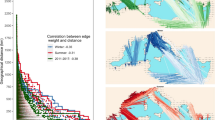Abstract
We introduce two simple descriptors and use the fractal dimension to characterize the capability of a monitoring network to either ‘spot’, ‘delineate’ or ‘track’ a pollution cloud moving across a territory. The descriptors are applied to the ‘European’ monitoring network for radioactive aerosol (i.e. the sum of the national networks). Simple analysis shows that on average the time and space resolution of the network are well balanced for tracking the movement of a radioactive cloud. Such tracking, however, can only be started one or two days after the release. The geographical inhomogeneity of the network is quantified by a fractal dimension of 1.6, implying that radioactive clouds with a dimension less than 0.4 might not be detected by the network.
Similar content being viewed by others
References
Doury, A.: 1980, ‘Pratiques francaises en materie de precision quantitative de la pollution atmospherique potentielle liee au activites nucleaires’, Proc. CEC Seminar on Radioactive Releases and their Dispersion in the Atmosphere Following a Hypothetical Reactor Accident. Risø, Denmark, April 1980.
Gifford, F.: 1988, ‘A simple theory for the description of cloud spreading at ranges from 1–2000 km’ in van Dop, H. (ed.) Air Pollution Modelling and its Applications 6 NATO CCMS, Plenum Press, pp. 569–577.
Lovejoy, S.: 1982, ‘Area-perimeter relation for rain and cloud areas’, Science, 216, 185–187.
Lovejoy, S., Schertzer, D. and Ladoy, P.: 1986, ‘Fractal characterization of inhomogeneous geophysical measurering networks’, Nature, 319 (6048), 43–44.
Mandelbrot, B.: 1982, The Fractal Geometry of Nature, W. H. Freeman, New York.
Mandelbrot, B. B.: 1986, ‘Self-affine fractal sets’ Pietronero, L. and Tosatti, E. (Eds.) In Fractals in Physics, North-Holland, Amsterdam, pp. 3–28.
Munn, R. E.: 1981, Design of Air Quality Monitoring Networks, Macmillan, London.
Raes, F., Tassone, C., Grippa, G., Zarimpas, N. and Graziani, G.: 1990a ‘Updating long range transport model predictions using real-time monitoring data in case of nuclear accidents with release to the atmosphere’, Atmospheric Environment (accepted for publication).
Raes, F.: 1990b, ‘Monitoring of environmental radioactivity in the European Community: inventory of methods and development of data quality objectives’, Commission of the European Communities, EUR 12801 EN.
Raes, F. and Graziani, G.: 1990c ‘The multi-fractal nature of radioactivity deposition on soil after the Chernobyl accident’, Health Physics (in print).
Weiss, W., Stöhlker, U., Bieringer, P., Zähringer, M. and Sartorius, H.: 1990, ‘The interpretation of gamma dose rate measurements in terms of airborne and deposited activity’, in Real Time Radioactivity Monitoring and its Interface with Predictive Atmospheric Transport Modelling proceedings of the 2nd REM Workshop, Ispra, 5–6 dec 1989. Commission of the European Communities, EUR 12990 EN.
Author information
Authors and Affiliations
Rights and permissions
About this article
Cite this article
Raes, F., Graziani, G. & Girardi, F. A simple and fractal analysis of the European on-line network for airborne radioactivity monitoring. Environ Monit Assess 18, 221–234 (1991). https://doi.org/10.1007/BF00398701
Issue Date:
DOI: https://doi.org/10.1007/BF00398701




